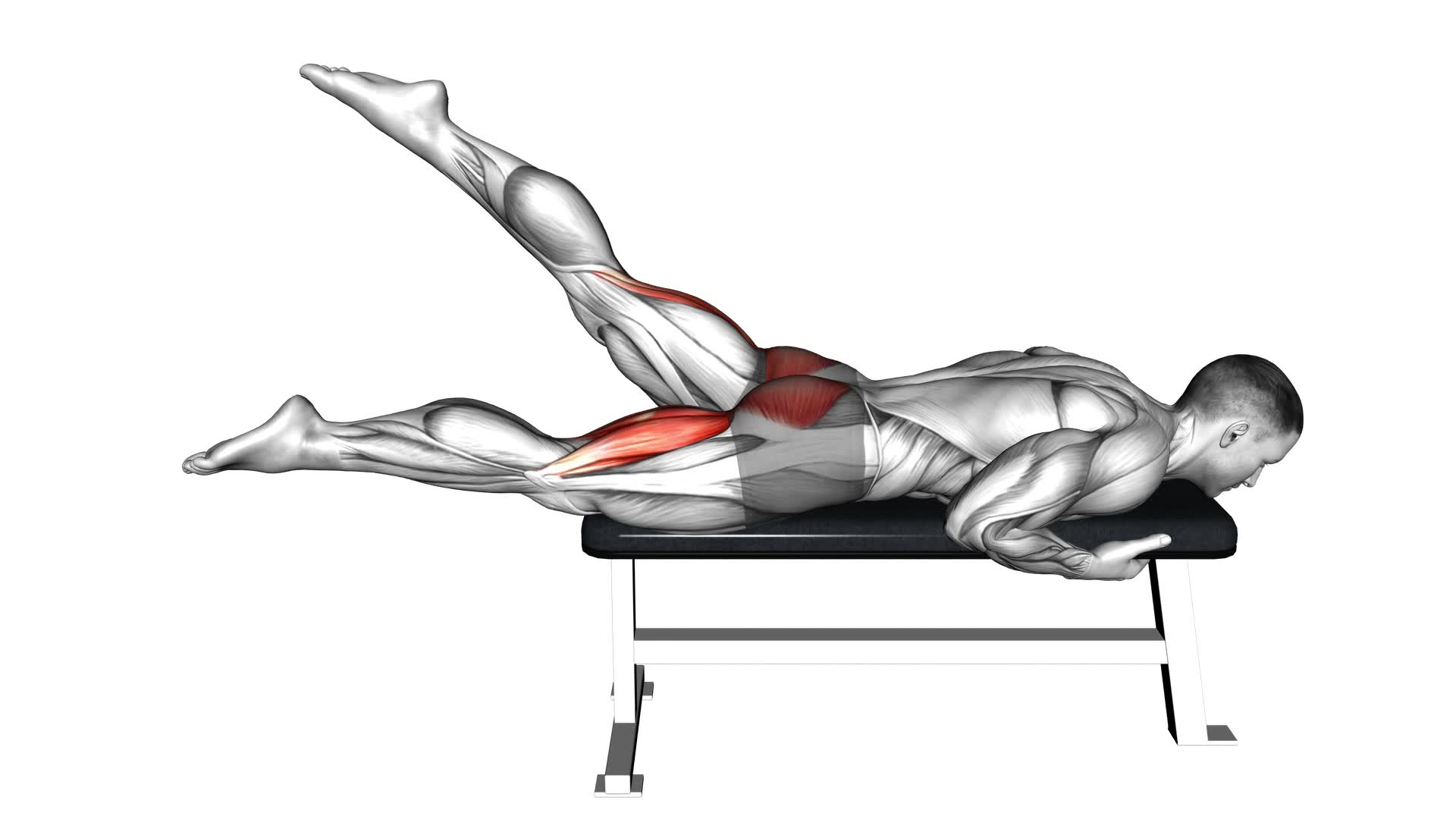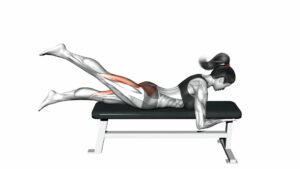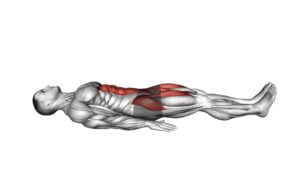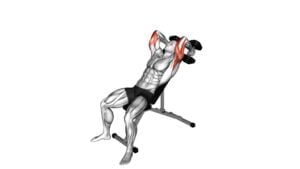Lying Alternate Hip Extension (male) – Video Exercise Guide & Tips

Are you looking to strengthen your hips and improve flexibility? In this video exercise guide, we'll show you how to perform lying alternate hip extension.
Watch This Exercise Video
This exercise targets the glutes, hamstrings, and lower back, helping you build a stronger lower body. With just a few minutes a day, you can increase your strength and mobility.
Follow along in the video and learn proper form, common mistakes to avoid, and tips to take your hip extension to the next level.
Let's get started!
Key Takeaways
- Lying Alternate Hip Extension strengthens the glute muscles, specifically the gluteus maximus.
- It can be modified for beginners by focusing on glute activation with feet on the floor.
- Proper form, including core engagement and avoiding common mistakes, is crucial for effectiveness.
- Variations and progressions, such as single-leg hip extension and using resistance bands, can increase intensity and target different muscle groups.
Benefits of Lying Alternate Hip Extension
One benefit of the lying alternate hip extension exercise is that it strengthens your glute muscles. This exercise specifically targets the gluteus maximus, which is the largest muscle in your buttocks. By engaging in this exercise, you can enhance muscle activation in your glutes, leading to improved strength and stability in your lower body.
In addition to strengthening your glute muscles, the lying alternate hip extension exercise provides an opportunity for progressions and regressions. If you're a beginner, you can start by performing the exercise without any added resistance. As you become more advanced, you can gradually increase the difficulty by using resistance bands or ankle weights. This allows you to continually challenge your glute muscles and make progress over time.
On the other hand, if you find the exercise too challenging initially, you can modify it by performing a regression. Instead of lifting your leg off the ground, you can start by simply focusing on activating your glute muscles while keeping your feet on the floor. This modified version allows you to build strength and gradually work your way up to the full exercise.
Now that you understand the benefits and progressions/regressions of the lying alternate hip extension exercise, let's discuss the equipment needed for this exercise.
Equipment Needed for Lying Alternate Hip Extension
To successfully perform lying alternate hip extensions, you'll need a few essential pieces of equipment:
- A yoga mat or exercise mat: This will provide cushioning and support for your body as you perform the exercise.
- A stability ball: This is necessary to engage your core and add resistance to the movement. It will help you maintain balance and stability throughout the exercise.
- A set of dumbbells: These can be used to further challenge your muscles and increase the intensity of the hip extensions. They will help you build strength and definition in your glutes and hamstrings.
Make sure to have these equipment ready before you start the exercise. Having the proper equipment will ensure that you can perform the lying alternate hip extensions effectively and safely.
Essential Equipment for Extension
You will need some essential equipment for the lying alternate hip extension exercise. To perform this exercise, you have a few equipment options.
The most common and recommended equipment is a yoga mat or an exercise mat to provide cushioning and support for your body. Additionally, you may want to use a stability ball or a bench to rest your upper body on during the exercise. These items can help maintain stability and proper form throughout the movement.
When it comes to the best techniques for the lying alternate hip extension, it's essential to focus on engaging your glutes and core muscles while maintaining proper alignment. By using the right equipment and following the correct techniques, you can maximize the effectiveness of this exercise.
Now, let's explore some alternatives to hip extension.
Alternatives to Hip Extension
If you're looking for alternatives to hip extension exercises that require equipment, there are a few options you can consider. These alternative exercises can still target the muscles effectively without the need for specific equipment.
Here are three alternatives you can try:
- Standing glute kickbacks: Stand upright and lift one leg straight back, squeezing your glutes at the top of the movement. Repeat on the other leg.
- Donkey kicks: Get on all fours with your hands directly under your shoulders and knees under your hips. Lift one leg up and back, keeping it bent at a 90-degree angle. Squeeze your glutes at the top and repeat on the other leg.
- Fire hydrants: Start on all fours, then lift one leg out to the side, keeping your knee bent. Squeeze your glutes at the top of the movement and repeat on the other leg.
Benefits of Hip Extension
Incorporating the lying alternate hip extension exercise into your routine provides numerous benefits, especially when utilizing the necessary equipment.
Hip extension exercises are effective in strengthening the muscles in your hips, glutes, and lower back, improving your overall stability and mobility.
By performing hip extension exercises, you can develop stronger and more powerful hip muscles, which can enhance your performance in various activities such as running, jumping, and squatting.
Additionally, hip extension exercises can help alleviate lower back pain and improve your posture.
To perform hip extension exercises, lie on your stomach with your legs extended. Lift one leg off the ground, keeping it straight, and then lower it back down. Alternate between legs and repeat for the desired number of repetitions.
Remember to engage your core and avoid arching your back during the exercise.
Proper Form for Lying Alternate Hip Extension
To perform the lying alternate hip extension exercise with proper form, start by lying on your back. Here are some key tips to ensure you maintain the correct technique:
- Keep your core engaged throughout the exercise to stabilize your spine and protect your lower back.
- Place your arms by your sides, palms facing down, for added stability.
- Lift one leg off the floor, keeping it straight and extended while maintaining a slight bend in the knee of the opposite leg.
By following these guidelines, you can maximize the benefits of the lying alternate hip extension exercise. This exercise primarily targets the glutes and hamstrings, helping to strengthen and tone these muscles. It also engages the core, improving stability and balance.
However, it's important to be aware of common mistakes that can compromise the effectiveness of the exercise. Avoid these errors to ensure you're getting the most out of your workout:
- Avoid lifting your leg too high, as this can strain the lower back. Focus on a controlled movement within a comfortable range of motion.
- Don't allow your hips to tilt or rotate. Keep them level throughout the exercise to maintain proper alignment.
- Be mindful of your breathing. Exhale as you lift your leg and inhale as you lower it back down.
Common Mistakes to Avoid During Lying Alternate Hip Extension
To get the most out of your lying alternate hip extension exercise, it's important to avoid common mistakes.
One common mistake is improper hip alignment, which can lead to inefficient movement and potential injury.
Another mistake to avoid isn't utilizing a full range of motion, as this can limit the effectiveness of the exercise.
Proper Hip Alignment
One common mistake to avoid during lying alternate hip extension is allowing your hips to become misaligned. Proper hip alignment is crucial for targeting the correct muscles and maximizing the effectiveness of the exercise.
Here are three tips to ensure proper hip alignment during lying alternate hip extension:
- Keep your hips level: Make sure both hips are aligned and remain parallel to the floor throughout the movement.
- Engage your core: Activate your core muscles to stabilize your pelvis and maintain proper alignment.
- Avoid excessive arching or rounding of the lower back: Maintain a neutral spine position to prevent strain on the lower back and maintain optimal hip alignment.
By following these tips, you can perform the exercise with proper hip alignment, enhancing its benefits and reducing the risk of injury.
Now, let's move on to discussing the importance of achieving a full range of motion.
Full Range of Motion
Achieving a full range of motion is crucial for maximizing the effectiveness of the lying alternate hip extension exercise and avoiding common mistakes.
To ensure you're performing the exercise correctly, focus on maintaining a wide range of motion throughout the movement. This will help target the muscles in your hips and glutes more effectively, leading to better results.
Having good hip flexibility is essential for achieving the full range of motion in this exercise. If you find it challenging to extend your leg fully, it may be a sign that you need to work on improving your hip flexibility.
By incorporating exercises that specifically target hip mobility into your routine, you can gradually increase your range of motion and get the most out of the lying alternate hip extension exercise.
Now, let's move on to the next section, which will provide tips to increase the intensity of the lying alternate hip extension.
Tips to Increase Intensity of Lying Alternate Hip Extension
To increase the intensity of your lying alternate hip extension, incorporate resistance bands or ankle weights into your workout routine. These additional tools will challenge your muscles and help you make progress in your fitness journey.
Here are three tips to help you increase the difficulty and maximize muscle activation during this exercise:
- Gradually increase resistance: Start with a lighter resistance band or ankle weights and gradually increase the tension or weight as your strength improves. This progressive overload will ensure continuous growth and prevent plateaus.
- Focus on mind-muscle connection: Concentrate on engaging your glutes and hamstrings throughout the movement. Visualize the muscles contracting and squeezing as you lift your leg, maximizing muscle activation and enhancing results.
- Control the tempo: Slow down the movement and maintain control throughout the exercise. By emphasizing the eccentric (lowering) phase of the movement, you'll further challenge your muscles and enhance muscle growth.
Remember to always listen to your body and adjust the intensity according to your fitness level. Incorporating these tips into your lying alternate hip extension routine will help you achieve greater strength and muscle development. Stay consistent and challenge yourself to reach new heights in your fitness journey.
Variations of Lying Alternate Hip Extension
To add variety to your lying alternate hip extension routine, try incorporating different variations of the exercise to target your glutes and hamstrings from various angles and intensities. By changing up the variations, you can challenge your muscles in new ways and prevent plateaus in your progress.
One variation you can try is the single-leg hip extension. Instead of alternating legs, you'll perform the exercise with one leg at a time. This variation increases the focus on the glute of the working leg and requires more stability and balance.
Another variation is the resistance band hip extension. Place a resistance band around your thighs, just above your knees, and perform the exercise as usual. The resistance band adds extra resistance, making the exercise more challenging and engaging your glutes and hamstrings even more.
To ensure proper form during these variations, lie on your back with your knees bent and feet flat on the ground. Keep your core engaged and lift one leg off the ground, extending your hip until your thigh is parallel to the ground. Lower your leg back down and repeat on the other side.
Incorporating these variations into your lying alternate hip extension routine will help you target your glutes and hamstrings from different angles and intensities, keeping your workouts fresh and effective. Remember to always prioritize proper form to maximize the benefits and minimize the risk of injury.
Frequently Asked Questions
How Many Sets and Repetitions Should I Do for Lying Alternate Hip Extension?
To determine the appropriate sets and repetitions for lying alternate hip extension, consider your workout intensity, variations, and progressions.
Start by focusing on the question at hand: how many sets and repetitions should you do? It's important to tailor the number of sets and repetitions to your fitness level and goals.
Consult with a fitness professional or trainer who can provide personalized guidance based on your specific needs.
Remember to gradually increase intensity and incorporate variations and progressions as you advance in your workouts.
Can Lying Alternate Hip Extension Help Improve My Running Performance?
Incorporating lying alternate hip extension into your running routine can indeed help improve your running performance. This exercise specifically targets your glutes and hamstrings, which are crucial muscles for running. By strengthening these muscles, you can generate more power and improve your stride efficiency.
To perform this exercise effectively, lie on your back with your knees bent and alternate lifting one leg at a time, extending your hips towards the ceiling. Focus on contracting your glutes as you lift your leg.
Is Lying Alternate Hip Extension Suitable for Beginners?
Lying alternate hip extension is a great exercise for beginners. It helps strengthen your hip muscles, improve flexibility, and enhance core stability. With proper form and technique, you can reap the benefits of this exercise, even if you're just starting out.
If you're finding it challenging, don't worry. There are modifications available, such as starting with smaller range of motion or using a resistance band for assistance. Stick with it, and you'll see progress in no time.
Can I Do Lying Alternate Hip Extension if I Have Lower Back Pain?
If you have lower back pain, it's important to exercise caution when considering the lying alternate hip extension. This exercise primarily targets the gluteal muscles, but it can also put strain on the lower back.
Modifications can be made to reduce the stress on your back, such as using a smaller range of motion or propping your upper body up on your forearms.
Remember to consult with a healthcare professional before attempting this exercise to ensure it's safe for you.
How Long Does It Take to See Results From Doing Lying Alternate Hip Extension Regularly?
To see results from regularly doing lying alternate hip extension, it depends on various factors. The optimal frequency for this exercise is about 2-3 times per week. Consistency is key, so stick to a routine.
Results may vary, but you can expect to see improvements in hip strength and stability within a few weeks. Remember to avoid common mistakes like arching your lower back or lifting too high. Focus on maintaining proper form throughout the exercise.
Conclusion
In conclusion, lying alternate hip extension is a beneficial exercise for strengthening the hip muscles. It requires minimal equipment and can be easily performed with proper form.
Avoiding common mistakes and following the provided tips can help increase the intensity of this exercise. Additionally, variations of lying alternate hip extension can be incorporated to add variety to your workout routine.
Incorporating this exercise into your fitness regimen can contribute to improved hip strength and overall lower body stability.

Author
Years ago, the spark of my life’s passion ignited in my mind the moment I stepped into the local gym for the first time. The inaugural bead of perspiration, the initial endeavor, the very first surge of endorphins, and a sense of pride that washed over me post-workout marked the beginning of my deep-seated interest in strength sports, fitness, and sports nutrition. This very curiosity blossomed rapidly into a profound fascination, propelling me to earn a Master’s degree in Physical Education from the Academy of Physical Education in Krakow, followed by a Sports Manager diploma from the Jagiellonian University. My journey of growth led me to gain more specialized qualifications, such as being a certified personal trainer with a focus on sports dietetics, a lifeguard, and an instructor for wellness and corrective gymnastics. Theoretical knowledge paired seamlessly with practical experience, reinforcing my belief that the transformation of individuals under my guidance was also a reflection of my personal growth. This belief holds true even today. Each day, I strive to push the boundaries and explore new realms. These realms gently elevate me to greater heights. The unique combination of passion for my field and the continuous quest for growth fuels my drive to break new ground.



